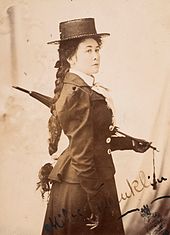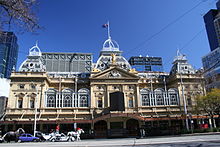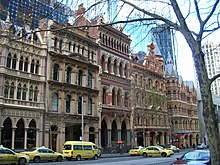Literature
As the convict era passed—captured most famously in Marcus Clarke's For the Term of His Natural Life (1874), a seminal work of Tasmanian Gothic—the bush and Australian daily life assumed primacy as subjects. Charles Harpur, Henry Kendall and Adam Lindsay Gordon won fame in the mid-19th century for their lyric nature poems and patriotic verse. Gordon drew on Australian colloquy and idiom; Clarke assessed his work as "the beginnings of a national school of Australian poetry". First published in serial form in 1882, Rolf Boldrewood's Robbery Under Arms is regarded as the classic bushranging novel.
Founded in 1880, The Bulletin did much to create the idea of an Australian national character—one of anti-authoritarianism,egalitarianism, mateship and a concern for the "battler"—forged against the brutalities of the bush. This image was expressed within the works of its bush poets, the most famous of which are Henry Lawson, widely regarded as Australia's finest short-story writer, and Banjo Paterson, author of classics such as "Clancy of the Overflow" (1889) and "The Man From Snowy River" (1890). In a literary debate about the nature of life in the bush, Lawson said Paterson was a romantic while Paterson attacked Lawson's pessimistic outlook. C. J. Denniswrote humour in the Australian vernacular, notably in the verse novel The Songs of a Sentimental Bloke (1915), while Dorothy Mackellarwrote the iconic patriotic poem "My Country" (1908) which rejected prevailing fondness for England's "green and shaded lanes" and declared: "I love a sunburnt country". Early Australian children's literature was also embedded in the bush tradition; perennial favourites include Norman Lindsay's The Magic Pudding (1918), May Gibbs' Snugglepot and Cuddlepie (1918) and Dorothy Wall's Blinky Bill (1933).
Significant poets of the early 20th century include Kenneth Slessor, Mary Gilmore and Judith Wright. The nationalist Jindyworobak Movement arose in the 1930s and sought to develop a distinctive Australian poetry through the appropriation of Aboriginal languages and ideas. In contrast, the Angry Penguins, centred around Max Harris' journal of the same name, promoted international modernism. A backlash resulted in the Ern Malley affair of 1943, Australia's most famousliterary hoax.
The legacy of Miles Franklin, renowned for her 1901 novel My Brilliant Career, is the Miles Franklin Award, which is "presented each year to a novel which is of the highest literary merit and presents Australian life in any of its phases".Patrick White won the inaugural award for Voss in 1957; he went on to win the 1973 Nobel Prize in Literature. Peter Carey, Thomas Keneally and Richard Flanagan are recipients of the Man Booker Prize. Other acclaimed Australian authors include Colleen McCullough, Nevil Shute, Tim Winton, Ruth Park and Morris West. Notable expatriate authors include the feminist Germaine Greer and humorist Clive James. Among the best known contemporary poets are Les Murray and Bruce Dawe.
David Unaipon is known as the first indigenous author. Oodgeroo Noonuccal was the first Aboriginal Australian to publish a book of verse. A significant contemporary account of the experiences of Indigenous Australia can be found in Sally Morgan's My Place. Contemporary academics and activists including Marcia Langton and Noel Pearsonare prominent essayists and authors on Aboriginal issues.
Charles Bean (The Story of Anzac: From the Outbreak of War to the End of the First Phase of the Gallipoli Campaign 4 May 1915, 1921) Geoffrey Blainey (The Tyranny of Distance, 1966), Robert Hughes (The Fatal Shore, 1987),Manning Clark (A History of Australia, 1962–87), and Marcia Langton (First Australians, 2008) are authors of important Australian histories.
Theatre
The ceremonial dances of Indigenous Australians recount stories of the Dreamtime and have been performed for thousands of years. European traditions came to Australia with the First Fleet in 1788, with the first production being performed in 1789 by convicts. In 1988, the year of Australia's bicentenary, the circumstances of the foundations of Australian theatre were recounted in Timberlake Wertenbaker's play Our Country's Good.
Hobart's Theatre Royal opened in 1837 and is Australia's oldest continuously operating theatre. Inaugurated in 1839, the Melbourne Athenaeum is one of Melbourne's oldest cultural institutions, and Adelaide's Queen's Theatre, established in 1841, is today the oldest purpose-built theatre on the mainland.The mid-19th century gold rushes provided funds for the construction of grand theatres in the Victorian style, such as the Princess Theatre in Melbourne, established in 1854.
After Federation in 1901, theatre productions evidenced the new sense of national identity. On Our Selection (1912), based on the stories of Steele Rudd, portrays a pioneer farming family and became immensely popular. Sydney's grand Capitol Theatre opened in 1928 and after restoration remains one of the nation's finest auditoriums.
In 1955, Summer of the Seventeenth Doll by Ray Lawler portrayed resolutely Australian characters and went on to international acclaim. That same year, young Melbourne artist Barry Humphries performed as Edna Everage for the first time at Melbourne University's Union Theatre. His satirical stage creations, notably Dame Edna and Les Patterson, became Australian cultural icons. Humphries also achieved success in the USA with tours onBroadway and has been honoured in Australia and Britain.
Founded in Sydney 1958, the National Institute of Dramatic Art boasts famous alumni including Cate Blanchett, Mel Gibson and Hugo Weaving.Construction of the Adelaide Festival Centre began in 1970 and South Australia's Sir Robert Helpmann became director of the Adelaide Festival of Arts.The new wave of Australian theatre debuted in the 1970s. The Belvoir St Theatre presented works by Nick Enright and David Williamson. The Sydney Opera House, inaugurated in 1973, is the home ofOpera Australia and the Sydney Theatre Company.
The Bell Shakespeare Company was created in 1990. A period of success for Australian musical theatre came in the 1990s with the debut of musical biographies of Australian music singers Peter Allen (The Boy From Oz in 1998) and Johnny O'Keefe (Shout! The Legend of The Wild One).
In The One Day of the Year, Alan Seymour studied the paradoxical nature of the ANZAC Day commemoration by Australians of the defeat of the Battle of Gallipoli. Ngapartji Ngapartji, by Scott Rankin and Trevor Jamieson, recounts the story of the effects on the Pitjantjatjara people of nuclear testing in the Western Desert during the Cold War. It is an example of the contemporary fusion of traditions of drama in Australia with Pitjantjatjara actors being supported by a multicultural cast of Greek, Afghan, Japanese and New Zealand heritage.
Architecture
Australia has three architectural listings on UNESCO's World Heritage list: Australian Convict Sites (comprising a collection of separate sites around Australia, including Hyde Park Barracks in Sydney, Port Arthur in Tasmania, and Fremantle Prison in Western Australia); the Sydney Opera House; and the Royal Exhibition Building in Melbourne. Contemporary Australian architecture includes a number of other iconic structures, including the Harbour Bridge in Sydney and Parliament House, Canberra. Significant architects who have worked in Australia include Governor Lachlan Macquarie's colonial architect, Francis Greenway; the ecclesiastical architect William Wardell; the designer of Canberra's layout, Walter Burley Griffin; the modernist Harry Seidler; and Jørn Utzon, designer of the Sydney Opera House. The National Trust of Australia is a non-governmental organisation charged with protecting Australia's built heritage.
Evidence of permanent structures built by Indigenous Australians before European settlement of Australia in 1788 is limited. Much of what they built was temporary, and was used for housing and other needs. As a British colony, the first European buildings were derivative of the European fashions of the time. Tents and wattle and daub huts preceded more substantial structures. Georgian architecture is seen in early government buildings of Sydney and Tasmania and the homes of the wealthy. While the major Australian cities enjoyed the boom of the Victorian era, the Australian gold rushes of the mid-19th century brought major construction works and exuberant Victorian architecture to the major cities, particularly Melbourne, and regional cities such as Ballarat and Bendigo. Other significant architectural movements in Australian architecture include the Federation style at the turn of the 20th century, and the modern styles of the late 20th century which also saw many older buildings demolished. The Queenslander is a term which denotes the primarily residential style of warm climate architecture developed in Queensland and northern parts of New South Wales.
Religious architecture is also prominent throughout Australia, with large Anglican and Catholic cathedrals in every major city and Christian churches in most towns. Notable examples include St Patrick's Cathedral, Melbourne and St Mary's Cathedral, Sydney. Other houses of worship are also common, reflecting the cultural diversity existing in Australia; the oldest Islamic structure in the Southern Hemisphere is the Central Adelaide Mosque (built in the 1880s), and one of the Southern Hemisphere's largest Buddhist Temples is Wollongong's Nan Tien Temple. Sydney's Gothic-style Great Synagogue was consecrated in 1878.
Historically, Australian pubs have also been noted for often distinctive designs.
Significant concern was raised during the 1960s, with developers threatening the destruction of historical buildings, especially in Sydney. Heritage concerns led to union-initiated green bans, which saved significant examples of Australia's architectural past. Green bans helped to protect historic 18th-century buildings in The Rocks from being demolished to make way for office towers, and prevented the Royal Botanic Gardens from being turned into a car park for the Sydney Opera House.
- Resource: wikipedia














No comments:
Post a Comment